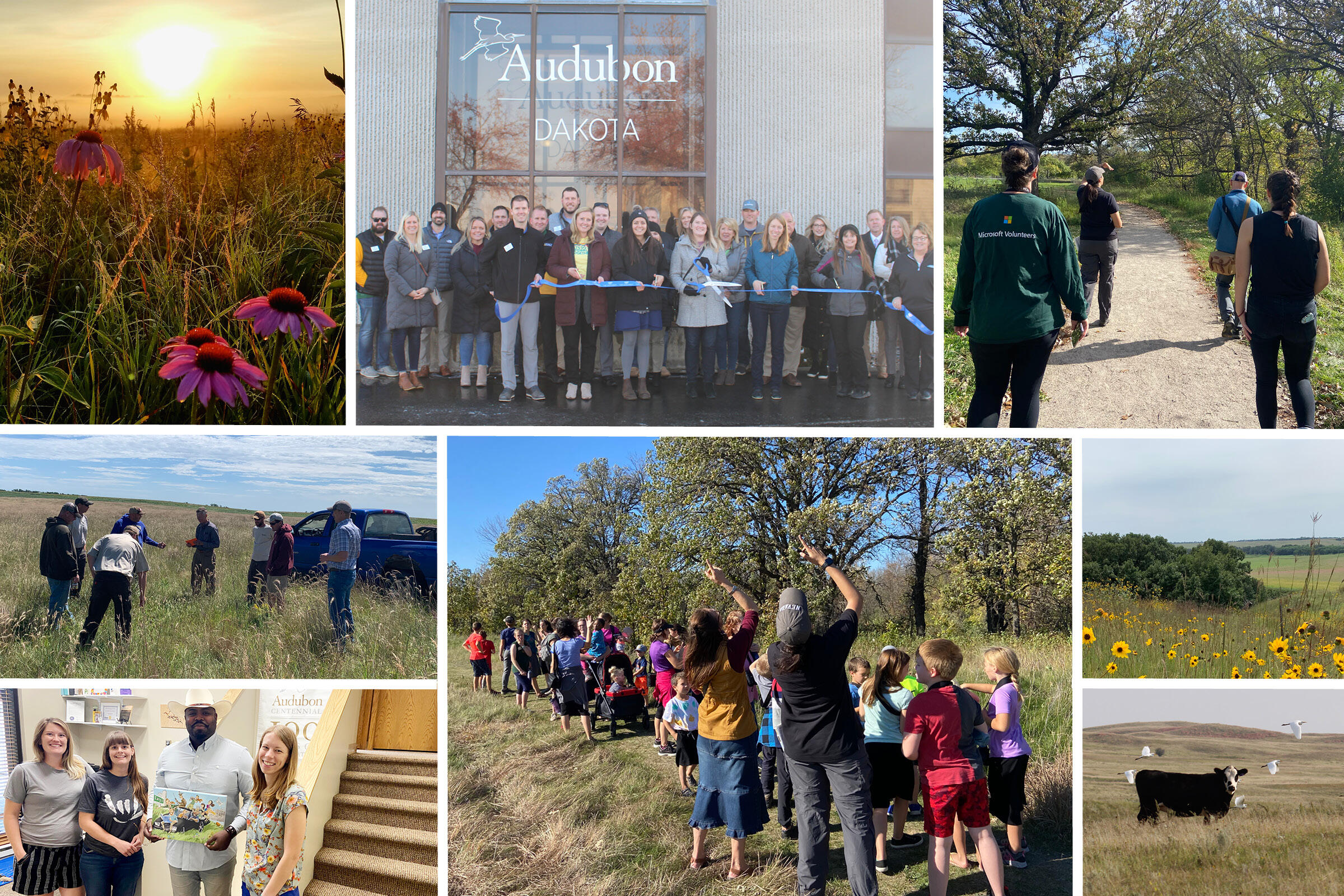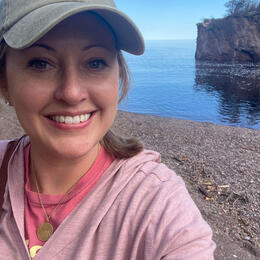This past year has been full of transitions and changes for Audubon Dakota, much like birds going through the molting process, we view this as new colorful plumage to symbolize the growth and change we have formed this year. From expanding our Audubon Conservation Ranching, leading a new coalition on prescribed fire, and providing numerous educational and outreach opportunities to our community, we have made the most of 2021 and can’t wait to do more.
Our working lands team is led by Joshua Lefers and includes Juli Bosmoe, Cody Grewing, and our newly hired Range Ecologist, Charli Kohler. Together they have expanded the Audubon Conservation Ranching (ACR) initiative, implemented prescribed fires, and worked with landowners on Prairie Management Toolbox projects. This spring they successfully signed an agreement with Panorama Meats to expand our Audubon Conservation Ranching program. This included enrolling half a million acres nationwide. Our team supported the habitat management plan as a part of this growth.
A coalition led by Audubon Dakota, the North Dakota Prescribed Fire Cooperative, enhanced 836 acres of land by completing 10 prescribed burns. The co-op supports landowners with prescribed burns to improve grasslands for cattle and wildlife while demonstrating the value of fire as a grassland management tool. Prescribed fires have been shown to increase diversity, improve habitat structure, reduce invasive grasses, reduce excessive thatch, and improve forage quality. A field tour hosted this fall included speakers discussing prescribed fire research and science, on-the-ground logistics, and the impact of fire on grassland ecology.
The working lands team completed and continues to work on toolbox projects in North and South Dakota. In North Dakota, six toolboxes were initiated this spring. These projects are impacting grazing management and bird habitat on 2,372 acres. On another project, in cooperation with North Dakota Game and Fish and Stutsman County Soil Conservation District, the working lands team removed invading Russian olive on 90 acres. The first ever completed South Dakota Prairie Management Toolbox project consisted of controlling Eastern red cedar invasion with prescribed fire on 70 acres. The working lands team continues to support reducing woody species invasion on 3,000 acres within a larger 30,000 acre block of habitat in Mellette County with a project that was started in July and will continue through 2023. Audubon Dakota provided support for grazing infrastructure on 8,000 acres within the same project area to allow producers to improve grazing management for wildlife and grassland health.
Phase two of the South Dakota Wolsey Crane Important Bird Area (IBA) conservation project has been completed, which included identifying and securing a 1,000-acre easement that serves as a roost site during spring migration. Most of the acreage within the Wolsey IBA area is held privately, making it essential for Audubon and conservation organizations to stand up for habitat protection and restoration.
There’s still more! In fact, this has been one of the biggest projects we have been a part of to date! In June, the launch of the North Dakota Conservation Forage Program (CFP) offered an exciting opportunity for landowners in North Dakota to convert cropland to grasslands to increase available forage and habitat for wildlife, and specifically for our grassland birds on 18,000 acres of land. The CFP is supported by a multi-million-dollar grant that was awarded by the Outdoor Heritage Fund and is backed by eight conservation partners in North Dakota. We are excited to continue this work and review applications for CFP during the upcoming months.
Under the direction of Sarah Hewitt, various stages of integrated prairie management practices were implemented across 807 acres in 34 enrolled urban nature parks as a part of our Urban Woods and Prairies Initiative. Along with the usual weed control and spot spraying, two Moorhead sites received prescribed burns to reduce the presence of invasive vegetation and stimulate the regrowth of native plant species. In a new win for the ewe-nique partnership between Audubon Dakota and Harvest Hope Farm, the City of Moorhead passed an ordinance allowing a sheep grazing pilot project in Oakport Prairie as a grassland management tool. Read this article from our Office Manager, Jodi Meisch, to learn more about the project, and stay tuned for progress updates! As we wrap up the year and plan for the next growing season, we continue the process of identifying future expansion sites and funding opportunities with various stakeholders including the Minot Park District, Ducks Unlimited, and the University of North Dakota, to name a few.
Like many offices worldwide, our team remained remote and worked from home the first portion of the year and returned in person in mid-June at a new office in Fargo. During this time, our Audubon Dakota team celebrated Marshall Johnson, Executive Director, as he transitioned into his new role at the national level as Interim Chief Conservation Officer and welcomed Suzanne Dixon, VP of the Mississippi Flyway, as Interim Chief Executive Director. Additionally, thanks to supporting grants, we welcomed Amanda Booher, in a newly created role, Communications Coordinator, to the flock.
In October our office began a monthly newsletter, the Dakota Dabbler, to update you on our work in conservation, volunteer events, to share our story, and maybe make you laugh a bit. Additionally, through public relations and social media, our communications efforts have amplified the many great projects of Audubon Dakota and helped us engage our community as we tell our story. Did you see us on North Dakota Today? KVRR? KFYRTV? Or hear us on Prairie Public radio? Check it out, we promise we won’t let it go to our heads.
Looking back at 2021, as the world slowly began to emerge from pandemic restrictions and in-person events were being held more often, we took care and pride to participate and host events that not only provided educational experiences for our guests but also kept everyone safe. Our Senior Coordinator of Engagement, Meghan Carter-Johnson, coordinated 47 engagement opportunities across the state, 11 of which were virtual, reaching over 15,000 attendees. First, hosted in conjunction with the Fargo Parks District was the eagerly anticipated return of the in-person Winter Birding Festival and Fargo Birding Festival. Over 200 participants grabbed their binoculars and joined us for a birding adventure this year.
At the Downtown Fargo Street Fair, we engaged with about 10,000 attendees over three days with our nature-based activities in an open-air tent. Every year we participate in Giving Hearts Day, and 2021 was no different. Outreach efforts remained mostly virtual, but were also successful, as we were able to raise over $17,000 from over 100 donors. People in the local community have donated not just their money but their time too. This past year over 100 volunteers donated their time and passion for birds and conservation. Most recently, we participated in CNN’s “Call to Earth” and hosted a volunteer event at Lions Conservancy Park. We had seven members of the community join us as we raked, weeded, and mulched the pollinator garden on a very drizzly November day.
We have had a wonderful, busy year and are looking forward to what 2022 will bring. At Audubon Dakota, we are continually grateful and in awe of the support of our community and the many great partnerships, it has to offer. Our work means so much to us, and we hope it means a lot to you too.






